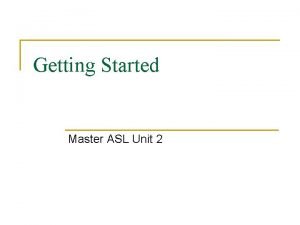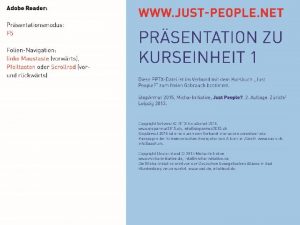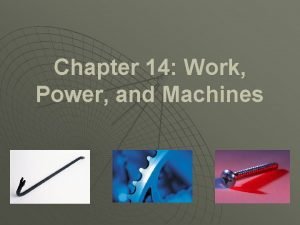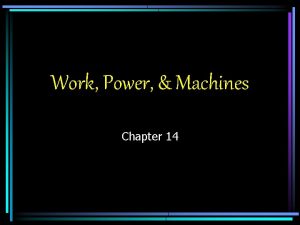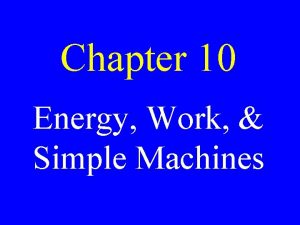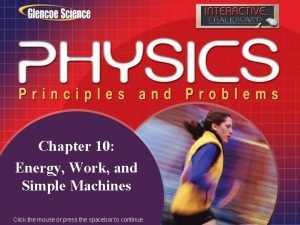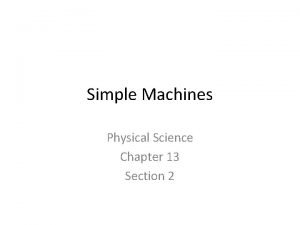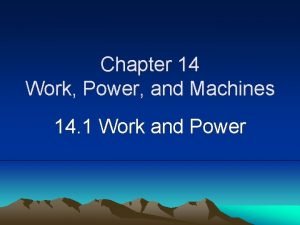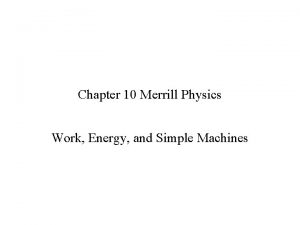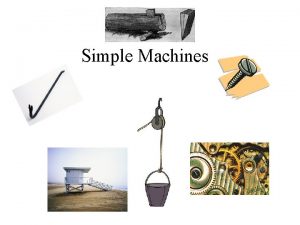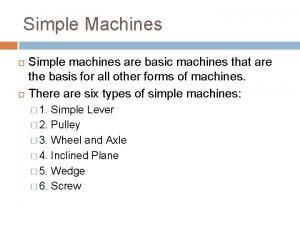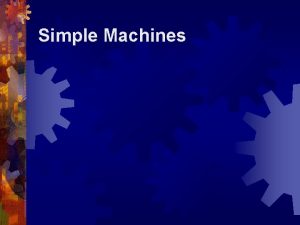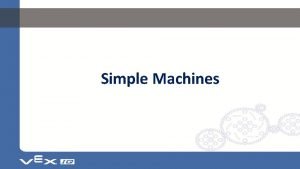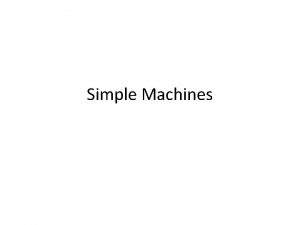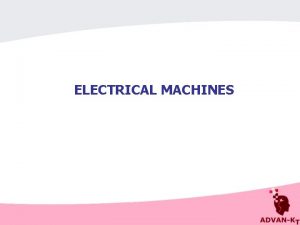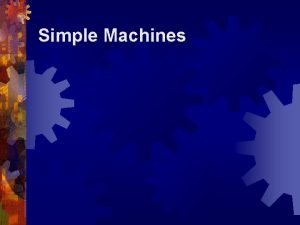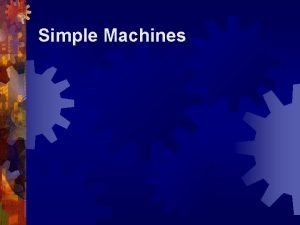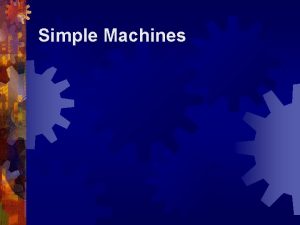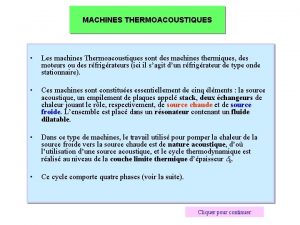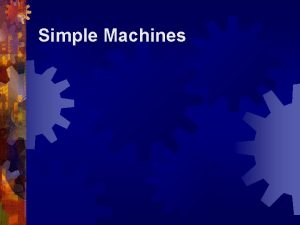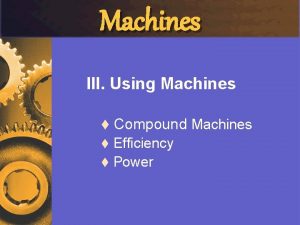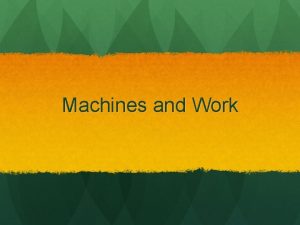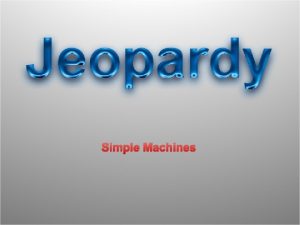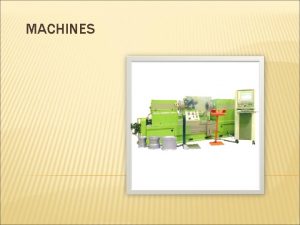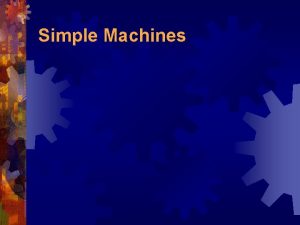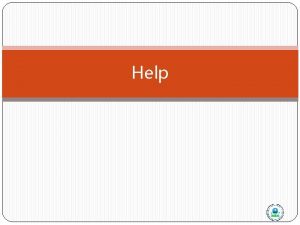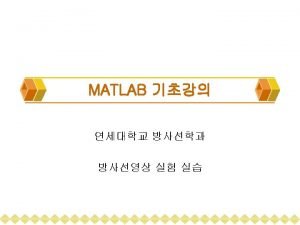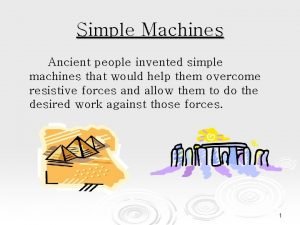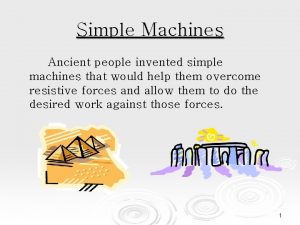CHAPTER 14 MACHINES 14 1 Machines help people

























- Slides: 25

CHAPTER 14: MACHINES

14. 1: Machines help people do work Machine: Any device that helps people do work. �Work is the use of force to move an object Does not decrease the amount of work that is done Only changes the way the work is done Example: Ramp pulley

How do machines help? Machines make the work easier by changing: The size of the force needed to do the work the distance over which the force is applied The direction in which the force is exerted Can be powered by different types of energy depending on the type of machine: Electronic machines use electrical energy Mechanical machines use mechanical energy �Mechanical energy is usually supplied by the person using the machine

Changing size and direction Some machines help by changing the size of the force needed If a machine allows you to exert less force, you must apply that force over a greater distance: Total amount of work remains the same whether a machine is used or not Work = force x distance Because a machine does not decrease the amount of work to be done, less force must mean a greater distance

Some machines allow you to apply a greater input force over a shorter distance (rake) You will move your hand a shorter distance to move the end of the rake a longer distance Input force: The force exerted on a machine When using a rake, the input force is the force from the boy on the rake Output force: The force that the machine exerts on an object This is the force that the rake exerts on the leaves

Machines can help you do work by changing the direction of a force: Flagpole: When raising the flag up the flagpole, you pull down on the rope to raise the flag up the pole The rope system does not change the size of the force, only the direction. �The force pulling the flag up is equal to the force you apply in your downward pull Shovel: Once you have the shovel in the ground, you push the handle down to lift the dirt up. A shovel also changes the size of the force you apply-you need less force to lift the dirt

Mechanical advantage of a machine Mechanical advantage MA The number of times a machine multiplies the input force Formulas to know: MA = output force ÷ input force Fout = MA x Fin = Fout ÷ MA

If your machine allows you to apply less force over a greater distance (doorknob) the output force is greater than the input force; MA is greater than 1 For machines that allow you to apply greater force over a shorter distance (rake) the output force is less than the input force; MA is less than 1 For machines that change only the direction of a force (rope system of a flagpole) the input and output forces are the same; MA is equal to 1

The output force of a machine is 600 N and the input force is 200 N. What is the MA of the machine? A machine has an input force of 150 N and a MA of 0. 5. What is the output force? The output force of a machine is 135 N and the MA is 2. 5. What is the input force?

Work transfers energy Machines transfer energy to objects on which they do work. If the machine lifts an object it gives off potential energy The higher you lift an object, the more work you do and the more energy you give the object A machine that causes an object to move gives the object kinetic energy

Output work is always less than input work Efficiency: The ratio of a machine’s output work to the input work An ideal machine would be 100% efficient so all of the input work would be converted to output work (not possible due to friction) Calculate efficiency: Efficiency (%) = (output work ÷ input work) x 100

If someone does 500 J of work on a pair of pliers and the pliers do 300 J of work on a wire, what is the efficiency of the pliers? E = Output ÷ Input x 100 Output = Input =

The more efficient the machine, the less mechanical energy is lost Some energy is lost to heat (friction) The more moving parts the machine has, the more energy is lost to friction Car engine: Efficiency is only about 25% due to the heat generated Typical electric motors are about 80% efficient Increase efficiency: Decrease friction Decrease air resistance

14. 2: Six simple machines There are six machines on which all other mechanical machines are based: Inclined plane Lever Wheel and axle Pulley Wedge screw

Lever: A solid bar that rotates, or turns, around a fixed point (fulcrum) Bar can be straight or curved Can multiply the input force Can also change the direction of the input force 3 classes of levers all with different arrangements of the fulcrum, input force (effort), and output force (resistance)

First-class lever: Fulcrum is located between the input force and the output force Used to change the direction and size of the force Second-class lever: Output force is located between the input force and the fulcrum Used when a greater output force is needed Third-class lever: Input force is between the output force and the fulcrum Used to reduce the distance over which you apply the input force OR increase the speed of the end of the lever

1 st class lever system 2 nd class lever system 3 rd class lever system

Wheel and Axle Made of a wheel attached to a shaft or axle Act as a rotating collection of levers Axle at the wheel’s center is like a fulcrum Screwdrivers, steering wheels, doorknobs, electric fans

Pulley A wheel with a grooved rim and a rope or cable that rides in the groove As you pull the rope, the wheel moves Fixed pulley: Pulley that is attached to something that holds it steady Makes work easier by changing the direction of the force You must apply enough force to overcome the weight of the load any friction Distance you pull the rope is the same distance that the object is lifted

Movable pulley: One end of the rope is fixed but the wheel can also move. Load is attached to the wheel Person pulling the rope provides the output force that lifts the load Single movable pulley does not change the direction of the force-it multiplies the force �You would need only half the force which means you need twice the distance Block and tackle system Contains both fixed and movable pulleys Used to haul and lift very heavy objects


Inclined plane A simple machine made of a sloped surface (ramps) Makes work easier by supporting the weight of the object over the distance it travels The less steep the incline, the less force you need Which means the distance will increase

Wedge Simple machine with one thick edge and one thin edge Used to cut, split, or pierce objects; also to hold objects together Can be as simple as a doorstop, a chisel, or an ice scraper, blade of an ax Angle of cutting edge determines the input force needed (thick wedge with large angle needs more force to cut) Thin edges provide a smaller surface area for the force to act upon

Screw Inclined plane wrapped around a cylinder or cone to form a spiral Used to raise and lower weights and to fasten objects Distance between the threads of the screw determine the amount of force needed: Threads close together = less force over greater distance

Calculating MA of specific machines Inclined plane: Ideal MA = length of incline ÷ height of incline Wheel and Axle: Ideal MA = Radius of input ÷ Radius of output Lever: Ideal MA = distance from input force to fulcrum distance from output force to fulcrum
 Helper
Helper Freesurfer troubleshooting
Freesurfer troubleshooting Im being oppressed
Im being oppressed Self help and community help is the motto of
Self help and community help is the motto of My mother makes me chicken
My mother makes me chicken Master asl unit 2
Master asl unit 2 It helps us understand people and societies.
It helps us understand people and societies. People media example
People media example Where is the love lyrics 2016
Where is the love lyrics 2016 Recovery community
Recovery community People just people
People just people Chapter 14 work power and machines
Chapter 14 work power and machines Energy work and simple machines chapter 10 answers
Energy work and simple machines chapter 10 answers Chapter 14 work power and machines
Chapter 14 work power and machines Chapter 4 work and energy section 1 work and machines
Chapter 4 work and energy section 1 work and machines Chapter 10 energy, work and simple machines answer key
Chapter 10 energy, work and simple machines answer key Energy work and simple machines chapter 10 answers
Energy work and simple machines chapter 10 answers Wedge simple machine
Wedge simple machine Chapter 14 work power and machines
Chapter 14 work power and machines Chapter 10 work energy and machines
Chapter 10 work energy and machines Chapter 5 lesson 4 getting help
Chapter 5 lesson 4 getting help Chapter 5 lesson 4 mental and emotional problems
Chapter 5 lesson 4 mental and emotional problems Chapter 7 sports and entertainment marketing
Chapter 7 sports and entertainment marketing Chapter 16 people and empires in the americas
Chapter 16 people and empires in the americas Chapter 14 lesson 4 people of the south
Chapter 14 lesson 4 people of the south Ordinary people chapter 22
Ordinary people chapter 22





